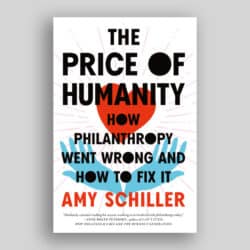Cap in Hand: How Charities are Failing the People of Canada and the World, by Gail Picco, Toronto, Civil Sector Press, 2016, ISBN 978-1-927375-41-9
The Canadian charitable sector impacts all of us through the messy business of living and dying in the shifting political, religious, business, family, and social contexts of this 21st century. Any book that promises insight into this world ought therefore to be welcomed. Those of us familiar with the sector know that its complexity is not always well understood or reflected in books dealing with Canadian charity or philanthropy.
It is not only the sector’s size in number and financial terms, but the range of work undertaken that is not well appreciated. The work of charities ranges from local community collaborations to international projects, from singular artistic expression to global environmental care, and from early learning through post-doctoral academia, and beyond. The diversity does not end there, as small grassroots engagements work in the same sector as those with legal and financial sophistication; attending to history coexists with future focus; physical endeavour (such as health, activity, and interaction) cohabits with technological initiatives, research, and inquiry ranging from the smallest of matters to horizons, issues, activities, and subjects not yet discovered. Even then, the charitable sector is not completely described.
So perhaps I should have suspected that a book with the title Cap in Hand: How Charities are Failing the People of Canada and the World might not capture the full spectrum of purposes, models, and methods featured in the Canadian charity landscape.
The failure by the public and decision-makers to appreciate the full scope and many facets of this chronically underestimated sector is an ongoing problem. The discrepancy between the legal use of the term “charity” and its vernacular meaning, among other issues, results in the term being one of the most misunderstood words in the Canadian lexicon. One hopes that literature on this topic would help in developing understanding that charities have a broader role, bigger purpose, more expansive footprint, and greater impact than is commonly thought.
That said, it is fair to attempt to critique the sector in which, as in all endeavours, there exist best practices, flaws, shortcomings, and where there is always learning to be done. This is best done from a well-informed stance. Here, based on personal experience in some of the areas covered by the author, I was troubled that a number of the observations were not as nuanced as I would have expected them to be, and was therefore wary of some of the other generalizations and conclusions reached by the author.
At the broadest level, Cap in Hand, the title, either plays on, or into, the misconception of charities as being “charity cases” themselves, typically supported through handouts rather than thoughtful investment. Given the actual composition of the sector, this suggests a severely limiting perspective for a book seeking to:
- Inspire more probing interest in, and transparency by, the sector;
- Stress the importance of increased sharing of the considerable data, knowledge, and expertise within the sector; and
- Challenge charities and their supporters to find real solutions to difficult issues, creating systemic change rather than simply attending to the outcomes.
These laudable goals are familiar themes in the Canadian charity experience. The author sets herself a tough assignment, though, in attempting to cover this broad context in a short book. The assignment becomes even more difficult with a focus on a few examples drawn from such slender slivers of the sector. The experiences of cancer research, hospital foundations, and the controversies in approaches to international aid do not a full charitable spectrum make.
This is not to say that what statistical information that is included is not useful, such as the work undertaken by Mark Blumberg to distill and present various snapshots of the sector including size, relative sizes, and funding sources, to name but a few.
However, an assertion such as there are only “10 pages of legislation regulating the registration of charities” belies the complexity of constituting and operating charities and the levels of regulation and reporting to which charities are subject on an ongoing basis. It takes but a few short minutes on the website maintained by the Canada Revenue Agency (CRA) to understand more fully the subtleties of regulating even a donation receipt, not to mention all of the other aspects of charitable operations.
Indeed, one of the documents in CRA’s extensive website collection is “S7-F1-C1, Split-receipting and Deemed Fair Market Value,” which highlights the limitations on issuing a donation receipt when the donor (or someone not at arms-length to the donor) receives an advantage in connection with the donor’s gift.
I mention this document specifically because I was troubled by the hypothetical illustration used in the book to portray how donations reduce government coffers. The example, in my view, overstates, in both scale and amount, the tax benefits for the donor. Specifically, that scenario contemplates the donor receiving a receipt for the full value of the gift without that receipt amount being reduced, as contemplated by S7-F1-C1, by the substantial advantage stated to be received by the donor’s business. In limited circumstances, such as an advantage of nominal value, as described in the guidance, it is not necessary to deduct the value of the advantage from the receipt, but those circumstances are highly circumscribed, and are not the norm (or seemingly applicable in the example offered by the author).
Other elements of that example, and more generally observations throughout the chapter on tax incentives, also suggest to me a lack of fluency on the part of the author with the application of the tax principles at work and the effects of tax incentives generally. Her approach to the place, purposes, and outcomes of endowment giving similarly lack depth.
Given the recent history of the sector, a discussion of charities’ political activism/activities is to be expected in a text of this sort. While some theoretical frameworks are noted, encouragement of political activism/activity by charity is not complete without also addressing the consequences (real and perceived) to charities that have done so. Dealing with the experiences of Canadian environmental charities over the last few years in this regard would have been particularly interesting. Even now, media reports of the multimillion-dollar CRA audit program put into place in 2012 (targeting 60 charities believed to be undertaking political activities) indicate that, although CRA halted the remaining audits not yet started, at least some of those in progress have been allowed to continue. This initiative has led in some past cases to threats to revoke a charity’s charitable status with significant ramifications, and those with audits pending face a similar risk.
Extrapolating to general conclusions from very specific scenarios is always fraught with problems where so many variables exist. While in no position to dispute the details of the specific examples presented in Cap in Hand, I am aware of any number of charities whose experiences differ from those that are described here.
This book’s premise places much responsibility for systemic societal change heavily on Canadian charities. This is not convincing in the absence of a more comprehensive assessment of the key roles played by political parties, their election platforms and their funding priorities when (or if) they win government; by other democratic and economic institutions; and, by the values that Canadians define and transmit between each other and through generations. Rather, it suggests that there is another story yet to be told.


